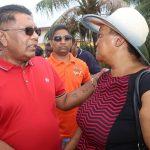The Better Hope to Sparendaam sea shore has seen an increase of natural mangrove regeneration. This was discovered through the National Agricultural Research and Extension Institute’s (NAREI) monitoring of the plants. NAREI will now be planting seedlings in this area to support and speed up the mangrove re-development process.
Kean Mosley, Head of the Mangrove Restoration Project explained that NAREI undertook a mangrove restoration project a few years ago in Chateau Margot to Le Ressouvenir, East Coast Demerara which has yielded a healthy mangrove forest. It was while the monitoring that project, that the seedlings along the Better Hope to Sparendaam area were discovered.

Mangrove seedlings which will restore the Better Hope to Sparendaam area under the Guyana Mangrove Restoration Project
Mosley said that this undertaking is aimed at strengthening the sea defence structures to prevent flooding. “Part of NAREI’s Mangrove Restoration Project deals with planting mangrove seedlings in areas where they are suitable to support sea defences along the coastline,” she said.
NAREI’s team recently made a presentation to the members of the Better Hope Neighbourhood Democratic Council (NDC) to create awareness of the mangrove programme which will be carried out in that area. Special arrangements were made for fishermen to anchor their boats.
The Guyana Mangrove Restoration Project is funded through a partnership between the Government of Guyana and the European Union (EU). It is implemented by the Ministry of Agriculture through NAREI. The objective of the project is to seek the commitment of Guyanese towards the protection and development of sustainable mangrove forests to safeguard the sea defence. The project commenced activities in February 2010.

Kean Mosley, Head of the Mangrove Restoration Project making her presentation on the Guyana Mangrove Restoration Project to members of the Better Hope Neighbourhood Democratic Council (NDC)
The mangrove project under the National Mangrove Management Action Plan (NMMAP) was implemented to respond to climate change and to mitigate its effects through the protection, rehabilitation and wise use of Guyana’s mangrove ecosystems.
Mangroves have played a significant role in protecting Guyana’s sea and river defences. These salt-water tolerant plants, together with man-made sea defence structures provide protection for over 90 percent of Guyana’s population who live within the naturally low-lying flood prone areas along the coast.





